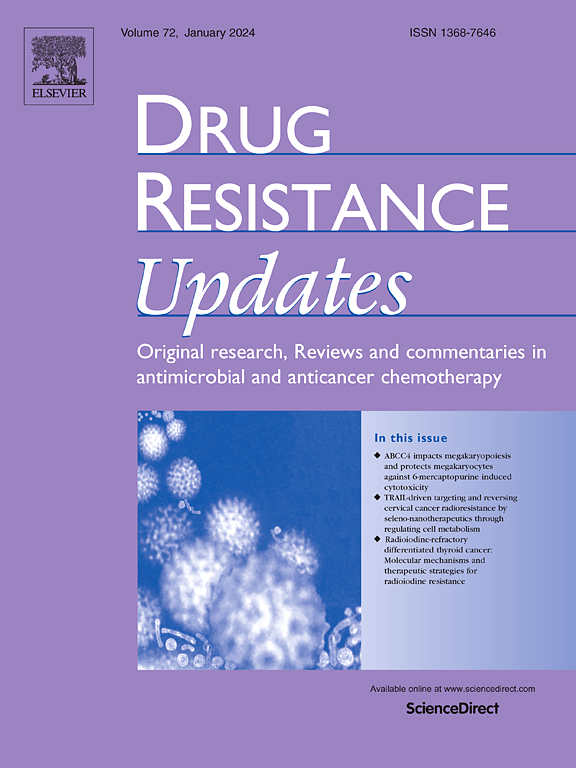Exploring treatment-driven subclonal evolution of prognostic triple biomarkers: Dual gene fusions and chimeric RNA variants in novel subtypes of acute myeloid leukemia patients with KMT2A rearrangement
IF 15.8
1区 医学
Q1 PHARMACOLOGY & PHARMACY
引用次数: 0
Abstract
Chromosomal rearrangements (CR) initiate leukemogenesis in approximately 50 % of acute myeloid leukemia (AML) patients; however, limited targeted therapies exist due to a lack of accurate molecular and genetic biomarkers of refractory mechanisms during treatment. Here, we investigated the pathological landscape of treatment resistance and relapse in 16 CR-AML patients by monitoring cytogenetic, RNAseq, and genome-wide changes among newly diagnosed, refractory, and relapsed AML. First, in FISH-diagnosed KMT2A (MLL gene, 11q23)/AFDN (AF6, 6q27)-rearrangement, RNA-sequencing identified an unknown CCDC32 (15q15.1)/CBX3 (7p15.2) gene fusion in both newly diagnosed and relapsed samples, which is previously unknown in KMT2A/AFDN-rearranged AML patients. Second, the unreported CCDC32/CBX3 gene fusion significantly affected the expression of wild-type genes of both CCDC32 (essential for embryonic development) and CBX3 (an oncogene for solid tumors) during the relapse, as demonstrated by Quantitative PCR analyses. Third, we further confirmed the existence of triple biomarkers - KMT2A/AFDN (AF6, 6q27) rearrangement, the unknown CCDC32 (15q15.1)/CBX3 (7p15.2) gene fusion and chimeric RNA variants (treatment-resistant leukemic blasts harboring distinct breakpoints) in a 21-year-old male patient of rapid relapsed/refractory AML. Most intriguingly, in this work regarding 16 patients, patients 7 and 20 initially showed the KMT2A/AFDN gene fusion; upon relapse, patient 20 did not show this fusion. On the other hand, patient 7 retained the KMT2A/AFDN fusion at diagnosis and during the relapse, only identified by PCR and Sanger's Sequencing, not by cytogenetics. Interestingly, the chimeric CCDC32/CBX3 gene fusion persisted in the 21-year-old male patient over the diagnostic and relapse phases. Most intriguingly, the overexpression of CCDC32/CBX3 fusion gene in AML patient-specific MV4-11 cells confirms the functional validation, providing experimental evidence of the biological impact of the CCDC32/CBX3 fusion on AML pathogenesis and treatment resistance by promoting cell cycle progression, a mechanism through which AML evolves to become treatment-resistant. All these might exhort differential resistance to treatment. Thus, we found that prognostic and predictive triple biomarkers - KRAS mutated, dual fusions (KMT2A/AFDN, CCDC32/CBX3), and chimeric variants - might evolve with a potential oncogenic role of subclonal evolution for poor clinical outcomes.
探索治疗驱动的预后三重生物标志物的亚克隆进化:双基因融合和嵌合RNA变异在KMT2A重排的急性髓系白血病新亚型患者中
染色体重排(CR)在大约50% %的急性髓性白血病(AML)患者中启动白血病发生;然而,由于在治疗过程中缺乏准确的难治性机制的分子和遗传生物标志物,靶向治疗存在局限性。在这里,我们通过监测新诊断、难治性和复发性AML的细胞遗传学、RNAseq和全基因组变化,研究了16例CR-AML患者的治疗耐药和复发的病理格局。首先,在fish诊断的KMT2A (MLL基因,11q23)/AFDN (AF6, 6q27)重排中,rna测序在新诊断和复发样本中发现了未知的CCDC32 (15q15.1)/CBX3 (7p15.2)基因融合,这在KMT2A/AFDN重排的AML患者中是未知的。其次,未报道的CCDC32/CBX3基因融合显著影响了CCDC32(胚胎发育必需基因)和CBX3(实体肿瘤致癌基因)野生型基因在复发期间的表达,定量PCR分析证实了这一点。第三,我们进一步证实了在一名21岁男性快速复发/难治性AML患者中存在三重生物标志物——KMT2A/AFDN (AF6, 6q27)重排、未知的CCDC32 (15q15.1)/CBX3 (7p15.2)基因融合和嵌合RNA变异(具有不同断点的治疗耐药白血病原细胞)。最有趣的是,在这项涉及16例患者的研究中,患者7和20最初表现出KMT2A/AFDN基因融合;复发后,患者20没有出现这种融合。另一方面,患者7在诊断和复发期间保留了KMT2A/AFDN融合,仅通过PCR和Sanger's测序,而不是通过细胞遗传学进行鉴定。有趣的是,嵌合的CCDC32/CBX3基因融合在21岁男性患者的诊断和复发阶段持续存在。最有趣的是,CCDC32/CBX3融合基因在AML患者特异性MV4-11细胞中的过表达证实了功能验证,为CCDC32/CBX3融合通过促进细胞周期进展对AML发病机制和治疗耐药的生物学影响提供了实验证据,这是AML进化为治疗耐药的机制。所有这些都可能导致对治疗的不同耐药性。因此,我们发现预后和预测性三重生物标志物- KRAS突变,双融合(KMT2A/AFDN, CCDC32/CBX3)和嵌合变异体-可能在亚克隆进化中具有潜在的致癌作用,从而导致不良的临床结果。
本文章由计算机程序翻译,如有差异,请以英文原文为准。
求助全文
约1分钟内获得全文
求助全文
来源期刊

Drug Resistance Updates
医学-药学
CiteScore
26.20
自引率
11.90%
发文量
32
审稿时长
29 days
期刊介绍:
Drug Resistance Updates serves as a platform for publishing original research, commentary, and expert reviews on significant advancements in drug resistance related to infectious diseases and cancer. It encompasses diverse disciplines such as molecular biology, biochemistry, cell biology, pharmacology, microbiology, preclinical therapeutics, oncology, and clinical medicine. The journal addresses both basic research and clinical aspects of drug resistance, providing insights into novel drugs and strategies to overcome resistance. Original research articles are welcomed, and review articles are authored by leaders in the field by invitation.
Articles are written by leaders in the field, in response to an invitation from the Editors, and are peer-reviewed prior to publication. Articles are clear, readable, and up-to-date, suitable for a multidisciplinary readership and include schematic diagrams and other illustrations conveying the major points of the article. The goal is to highlight recent areas of growth and put them in perspective.
*Expert reviews in clinical and basic drug resistance research in oncology and infectious disease
*Describes emerging technologies and therapies, particularly those that overcome drug resistance
*Emphasises common themes in microbial and cancer research
 求助内容:
求助内容: 应助结果提醒方式:
应助结果提醒方式:


